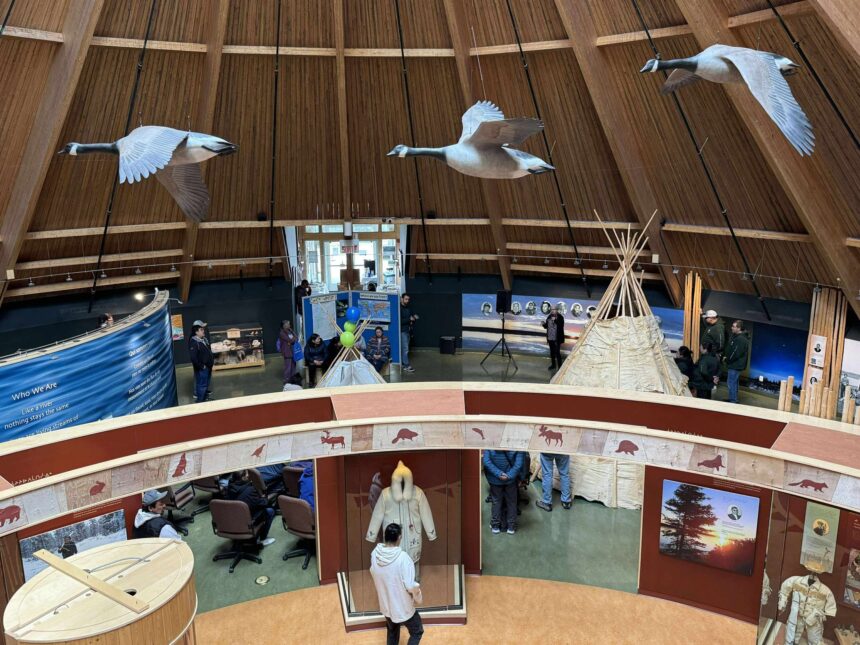The Cree Nation of Chisasibi’s Heritage & Cultural Centre (CHCC) has offered a permanent home for the community’s culture and languages for ten years. On Wednesday, August 27, the CHCC celebrated the 10th anniversary of the building, designed as a place for knowledge sharing. Offering a space for Elders to teach youth is a key role the CHCC was intended to play, but its other roles are equally important. The CHCC is a storage space for photo collections, library, and archives, and a cold-storage space for clothing and crafts made out of animal skins and furs. It is an exhibition space that welcomes visitors from all over, and it houses the offices for those who run the centre. Yet the building—modeled on the shaptuaan, a long tipi in East Cree —is one of the younger parts of the CHCC project. That project itself began in 2000 with photo collections, and the voices of Elders. Margaret Fireman was the original project manager for the CHCC and remains a part of the organization. “Our Elders that came to see us, they used to tell us stories about life back when we lived on the island of Fort George,” Fireman told APTN News. “And that’s how the project came about.” The modern community of Chisasibi moved to its current location from Fort George Island in 1980 due to changes in the flow of the La Grande River following the installation of Hydro Quebec dams. In 2000, organizers sat down with Elders to discuss the best ways to preserve the knowledge and history of Chisasibi. “We started talking about having a building in our community to showcase our heritage, our culture, our stories, and tell our story,” Fireman said. “It evolved over the years. Eventually we talked about storing [things]. Where are we going to store all the photo collections, all the material that people were bringing in? That’s when we started planning on building a Heritage and Cultural Center.” Read more: Born into a treaty and raised on resistance: Cree Youth mark 50 Years of the James Bay Treaty at the UN Cree community in Quebec opts out of sending delegation to see the Pope From the beginning, Fireman stressed, the process of planning the building occurred in the community. “We had three community youth who took drafting and architectural design that designed the building itself,” she explained. “Then we took all the drawings to the community meeting. We asked the committee members which one did they choose.” The community chose a simple, elegant building based on the familiar shaptuuan shape. The Chisasibi Heritage & Cultural Centre building, modeled on the shaptuuan or long tipi. Photo: Chissibi HCC For the first project in the new Heritage & Cultural Centre, Elders taught the process of making a birch-bark canoe like the ones featured in many of the historical pictures of the community held in the CHCC’s archival collections. “It was very distinctive for the people from Chisasibi to have that type of birch-bark canoe that was suitable for traveling out in the bay and inland, going on the river,” Fireman said. “That was one of the projects we did, just to have people know the kind of work we were doing and what we wanted to have people remember.” Later exhibitions showcased traditional wear. Fireman and the CHCC team asked hunters on the land to bring them furs, and from there Elders taught the process for making traditional wear out of beaver pelts, rabbit fur, and seal skins. Far from a simple display of fashion, the traditional clothing exhibition was connected to stories of Chisasibi families, such as one family known for wearing otter skin. Every summer, many Chisasibi residents return to Fort George Island for a community gathering, and at that event the CHCC told the stories associated with traditional wear. “We went back to the island and they reenacted an event where the community Elders told that story, and the young people and the old people and different adults wore the clothing,” Fireman explained. The CHCC employs people from the community with no particular background in museums and archives. “Most of our staff members went through training, because none of us knew what museum work was,” Fireman recalled. “We worked with an Ontario college where they already had Museum Studies. That was a heritage interpretation program.” The Heritage & Cultural Centre’s main exhibition room. Photo: Chisasibi HCC. Because virtually all Crees in Chisasibi speak East Cree—Iiyiyuu ayimuun—it is the first language used in all exhibitions. However, most Crees speak English as well, and some speak French. A trilingual museum required some training of its own. “We went through a language revitalization program with the University of Victoria in British Columbia,” Fireman said. “All of our staff followed that program in 2016-17 and most of them graduated.” Fireman was enthusiastic about working with outsiders as well, saying it created an opportunity for reciprocal, collaborative learning in which Crees learned from outsiders, and the outsiders learned about Cree culture. But she stressed the most important learning still occurs in the community. “We learn so much from our Elders, especially the values,” she added, “because a lot of our generation are from the residential school era, which is something that we didn’t learn.” As the CHCC celebrated its 10th anniversary, its plans for the future are already under way. Fireman said there remains some work to do in completing the exhibitions area, while every summer the CHCC welcomes students who come to work and learn. The CHCC’s current project is a partnership with Hydro-Québec that aims to tell the story of the community’s relationship with the La Grande river, particularly in the portage areas that existed prior to the dams built in the 1970s. “We worked on a project over here at the First Rapids, where our community did their fishing,” she said. “We put up interpretive panels there. [Hydro-Québec] had their own panels. They were talking about their installations at LG-1 [hydroelectric dam]. But when we met with them, we told them to take down their panels, and put up ours. We want our story there.” Continue Reading
Heritage & Cultural Centre in Cree Nation of Chisasibi celebrates 10th anniversary

Leave a Comment










